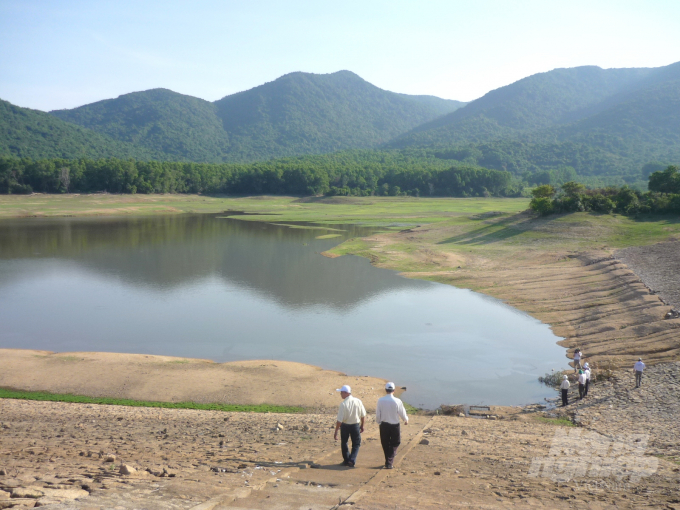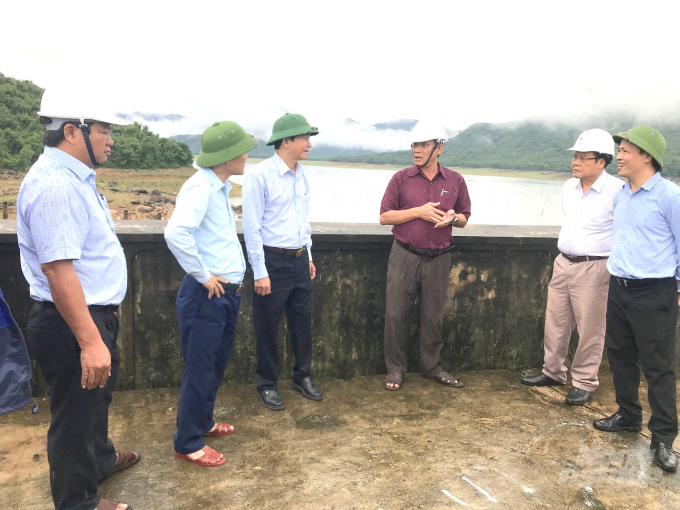November 28, 2025 | 02:29 GMT +7
November 28, 2025 | 02:29 GMT +7
Hotline: 0913.378.918
November 28, 2025 | 02:29 GMT +7
Hotline: 0913.378.918

Nui Mot lake in Nhon Tan commune only holds 17.3 million m3 while its design capacity is 110 million m3. Photo: Vu Dinh Thung.
According to Ho Dac Chuong, Director of the Irrigation Sub-Department, most of Binh Dinh’s 165 reservoirs have been exhausted due to prolonged heat before the recent flood.
For example: Nui Mot lake in Nhon Tan commune only holds 17.3 million m3 while its design capacity is 110 million m3. Or Hoi Son lake in Cat Son commune, 5.8 million m3/44.5million m3; Thuan Ninh lake in Tay Son district 11.2 million m3/35 million m3...
“The province’s largest reservoir, Dinh Binh lake, currently holds about 50 million m3, which is too low compared to the design capacity of 226.3 million m3. However, we are still discharging water downstream to prepare for floods according to the inter-reservoir operation process. Other reservoirs are holding only about 30% of the design capacity,” said Chuong.

The amount of water stored in 165 reservoirs in Binh Dinh is only 30% of the design capacity. Photo: Vu Dinh Thung.
In Phu Yen, those resevoirs managed by Dong Cam Irrigation One-member Company Limited are no different. Dong Tron Lake currently holds only more than 7.6 million m3 while its design capacity is 19.55 million m3; Phu Xuan lake only nearly 4 million m3/11.2 million m3; Suoi Vuc lake 3.3 million m3/10.5 million m3, Xuan Binh Lake 2.6 million m3/6.5 million m3; Ky Chau lake nearly 1.3 million m3/more than 3.8 million m3, Hoc Rom lake nearly 0.7 million m3/nearly 3 million m3; Lo An Lake 1.5 million m3/more than 2.6 million m3. The total water volume of these reservoirs is 21 million m3, less than 50% of the design capacity.
In Khanh Hoa, the level of water in some small lakes has reached 100% design capacity. For example: Suoi Trau lake with design capacity of 9.81 million m3; Suoi Luong lake 0.62 million m3; Cay Bua lake 0.30 million m3; The total water volume of these 19 reservoirs is only 121.69 million m3, 49% of the total design capacity.
Similar to Khanh Hoa province, a number of small reservoirs in Ninh Thuan are now nearly full, but does not quite meet the need to irrigate crops. For example, Phuoc Trung lake only 2.35 million m3; Phuoc Nhon Lake 0.23 million m3; Ma Trai lake 0.40 million m3; CK7 1.43 million m3.

The mission of the Ministry of Agriculture and Rural Development inspected Nui Mot reservoir in Nhon Tan commune (An Nhon town, Binh Dinh province). Photo: Vu Dinh Thung.
However, the large reservoirs are very “hungry” for water. For example: Song Trau Lake with a design capacity of 31.53 million m3 currently only holds 5.24 million m3; or Song Bieu lake with design capacity of 23.78 million m3 currently holds only 7.3 million m3; Lanh Ra Lake has a design capacity of 13.89 million m3 currently holds only 5.7 million m3. The total design capacity of 21 reservoirs in Ninh Thuan is 149.94 million m3, but currently these reservoirs hold only 82.82 million m3.
“We hope that the rains in the last months of the year will determine the water level in these reservoirs, but now the water flow to the reservoirs is very small. The water level in the big rivers is still below alarm level I”, said Ho Dac Chuong, Director of Binh Dinh Irrigation Sub-Department.
Author: Vu Dinh Thung. Translated by Huyen Dan. Edited by Duc Huy.

(VAN) On November 27, in the meeting with Minister Tran Duc Thang, Mayor Yin Yong shared Beijing’s experience to improve environment and air quality.

(VAN) After 30 years, both sides identified strategic areas of cooperation: sustainable production, increasing coffee value and training for farmers.
/2025/11/27/4910-4-164708_294.jpg)
(VAN) On the afternoon of November 27 in Beijing, Minister of Agriculture and Environment Tran Duc Thang held a working session with several major Chinese enterprises operating in the agriculture and environment sector.

(VAN) The Department of Animal Health issued a provisional guideline requesting local authorities to increase surveillance, collect samples for testing, and conduct epidemiological investigations according to the established procedure.

(VAN) The United Nations recommends that Vietnam utilize data and artificial intelligence to enhance early disaster warnings and reduce GDP losses by 3.2% in the context of climate change.

(VAN) On the morning of November 27 in Beijing, Minister Tran Duc Thang and the Deputy Commissioner General of the General Administration of Customs of China signed a protocol on fresh jackfruit exports.

(VAN) As floodwaters recede, a vast network of irrigation works across eastern Gia Lai is emerging in a state of severe disrepair, with extensive damage demanding urgent restoration ahead of the 2025-2026 winter-spring cropping season.